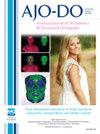患者的看法很重要:牙齿矫正中的风险沟通和社会心理因素。
IF 2.7
2区 医学
Q1 DENTISTRY, ORAL SURGERY & MEDICINE
American Journal of Orthodontics and Dentofacial Orthopedics
Pub Date : 2024-10-01
DOI:10.1016/j.ajodo.2024.06.011
引用次数: 0
摘要
导言:有效的风险沟通对于实现以患者为中心的口腔健康护理至关重要,但由于对患者对牙齿矫正相关风险的主观认知了解有限,阻碍了这一进程。本研究旨在调查成年人对长期正畸风险的认识、担忧和风险规避行为,并探讨它们与社会心理因素的关系:我们纳入了 498 名初次到中国成都一家医院正畸科就诊的成年患者(平均年龄为 27.3 ± 6.8 岁,女性占 75.5%)。在接触口腔健康教育漫画(OHEC)这一专门设计的数字工具之前和之后,我们对参与者对正畸风险的理解进行了评估。同时,我们使用逻辑回归模型研究了患者的抑郁、焦虑、自尊、完美主义和牙面美学与风险认知之间的关联:大约 79.5%的参与者最初表示对牙齿矫正风险的认识不足,其中大部分知识来自网络。值得注意的是,在OHEC之后,高认知度参与者的比例增加到了64.8%。参与者最担心的是面部软组织的负面变化:53.4%的人表示高度关注,28.1%的人表示高度回避。此外,线性回归表明,抑郁(β = 0.42 [95% 置信区间{CI},0.07-0.77])和焦虑(β = 0.76 [95% CI,0.35-1.18])与正畸风险呈正相关。18])正相关,而风险规避与抑郁(β = 0.62 [95% CI, 0.27-0.97])、焦虑(β = 1.09 [95% CI, 0.68-1.50])和完美主义(β = 0.24 [95% CI, 0.02-0.46])正相关:研究结果强调了在正畸学中简化风险交流的必要性。结论:研究结果表明,在正畸学中简化风险交流是非常必要的。通过结合OHEC等易懂的工具和社会心理评估,可以实现更精细的患者与执业医师的交流和以心身医学为基础的牙科护理。本文章由计算机程序翻译,如有差异,请以英文原文为准。
Patients’ perceptions matter: Risk communication and psychosocial factors in orthodontics
Introduction
Effective risk communication is essential for achieving patient-centered oral health care, but the limited understanding of patients’ subjective perceptions of orthodontic-related risks hinders this process. This study aimed to investigate adults’ awareness, concerns, and risk-avoidance behaviors about long-term orthodontic risks, exploring their relationship with psychosocial factors.
Methods
We included 498 adult patients (mean age, 27.3 ± 6.8 years; women, 75.5%) during their initial visits to the orthodontic department at a hospital in Chengdu, China. Participants’ understanding of orthodontic risks was gauged before and after exposure to the Oral Health Education Comics (OHEC), a specifically designed digital tool. Concurrently, we used logistic regression models to investigate the associations between patients’ depression, anxiety, self-esteem, perfectionism, and dentofacial esthetics with risk perceptions.
Results
Approximately 79.5% of participants initially reported low awareness of orthodontic risks, with most knowledge from online sources. Notably, the percentage of participants with high awareness increased to 64.8% after OHEC. The negative facial soft-tissue change was most concerning for participants: 53.4% showed high concerns, and 28.1% showed high avoidance. Furthermore, linear regression indicated positive associations between depression (β = 0.42 [95% confidence interval {CI}, 0.07-0.77]) and anxiety (β = 0.76 [95% CI, 0.35-1.18]) with orthodontic risk concerns, whereas risk avoidance was positively associated with depression (β = 0.62 [95% CI, 0.27-0.97]), anxiety (β = 1.09 [95% CI, 0.68-1.50]), and perfectionism (β = 0.24 [95% CI, 0.02-0.46]).
Conclusions
Findings emphasize the imperative of streamlined risk communication in orthodontics. By incorporating comprehensible tools such as OHEC and integrating psychosocial evaluations, more refined patient-practitioner communication and psychosomatic-based dental care can be achieved.
求助全文
通过发布文献求助,成功后即可免费获取论文全文。
去求助
来源期刊
CiteScore
4.80
自引率
13.30%
发文量
432
审稿时长
66 days
期刊介绍:
Published for more than 100 years, the American Journal of Orthodontics and Dentofacial Orthopedics remains the leading orthodontic resource. It is the official publication of the American Association of Orthodontists, its constituent societies, the American Board of Orthodontics, and the College of Diplomates of the American Board of Orthodontics. Each month its readers have access to original peer-reviewed articles that examine all phases of orthodontic treatment. Illustrated throughout, the publication includes tables, color photographs, and statistical data. Coverage includes successful diagnostic procedures, imaging techniques, bracket and archwire materials, extraction and impaction concerns, orthognathic surgery, TMJ disorders, removable appliances, and adult therapy.

 求助内容:
求助内容: 应助结果提醒方式:
应助结果提醒方式:


